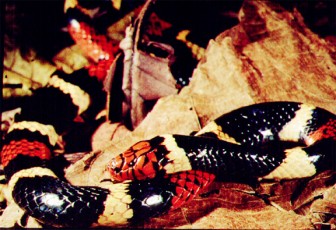“Red on black is a friend of Jack, red on yellow kills a fellow”!
This rhyme may apply to the North American coral snake but here in the tropics a bite from either snake may be fatal. Coral snakes are found in the family Elapidae, one of the five snake families found in Guyana.
This group of snakes also includes the cobras, mambas and the Australian Taipan. Based on preliminary studies there are four species of coral snake found in Guyana. These species are from the genus Micrurus. These include the largest and most commonly known of the corals in Guyana the Hymarali (Micrurus surinamensis) also know as the aquatic coral snake. Another coral that is also seen often is the South American Coral Snake (Mircurus lemniscatus).

The behaviour of coral snakes varies worldwide. Most, however, appear to be fossorial spending large amounts of time buried in the leaf litter on the forest floor only surfacing when it rains and for breeding. Despite being known for their potent venom, corals will attempt to flee a threat, biting only as a last resort. The fangs of coral snakes are fixed in the upper jaw and are very short, so when biting, corals tend to hold on and chew to ensure enough venom is administered to kill its prey.
Corals usually feed on other small snakes, frogs, lizards, birds, small mammals, fish, etc. The venom can take some time to take effect, but even if their venom is slow acting, if bitten immediate medical attention should be sought. Coral venom is a powerful neurotoxin that paralyses the breathing muscles and antivenin and artificial respiration would be needed to save the victim’s life.
Rain forests are rich in biodiversity and are home to many different plants and animals. In addition, indigenous communities make their homes there. Even if you don’t live in the rain forest, humans rely on the forest for resources such as building materials (wood and lianas), medicine and fruits. Rain forests also provide essential environmental services for life on earth; they create soil as well as prevent soil erosion, produce oxygen though photosynthesis, maintain clean water systems, and are a key defence against climate change.
The Iwokrama Rain Forest is 371,000 hectares, located in the heart of Guyana. Our mission is to develop strategies for conservation and sustainable development for local people in Guyana and the world at large. We are involved in tourism, training, research and our timber is certified by the Forest Stewardship Council. Come and visit us in the rain forest or at http://www.iwokrama.org.








